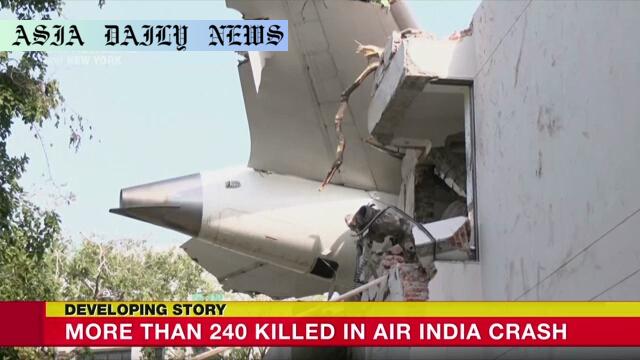Plane Crash: A Boeing 787 en route to London Gatwick crashed in Ahmedabad, killing 241 onboard and potentially more on the ground.

A Tragic Plane Crash in Ahmedabad, India
The city of Ahmedabad, India, was struck by tragedy on Thursday when a Boeing 787 Dreamliner operated by Air India crashed shortly after takeoff. Headed for London Gatwick Airport, the aircraft was carrying 230 passengers and 12 crew members, among which 241 people lost their lives in the catastrophic event. Miraculously, only one individual, a British citizen, survived. Nearby, the medical college building that was struck endured considerable damage, and authorities suspect there could be casualties among those on the ground. Surveillance footage reveals the plane struggling to gain altitude before it crashed and burst into flames.
Many families across the globe are grieving the loss of loved ones, given the plane’s diverse list of nationalities onboard. It carried 169 passengers from India, 53 from Britain, seven from Portugal, and one Canadian. World leaders and aviation organizations have responded with heartfelt condolences while emphasizing the need for a thorough investigation to bring clarity and resolution to this devastating incident.
A Closer Look at the Aircraft and Investigation
The Boeing 787 Dreamliner, often regarded as a modern marvel of engineering, entered the aviation scene approximately 14 years ago. However, its history hasn’t been entirely free of concern. The aircraft initially faced a series of grounding issues linked to its battery system in 2013. Although regarded as an advanced and safe design, this event marks the first major accident involving the 787 since its introduction to commercial aviation. Investigators are now delving deeply into the circumstances. The pilots reportedly issued a mayday alert in the moments before the crash, which adds further complexity to the investigation into the crash’s root cause.
Simultaneously, Boeing President Kelly Ortberg reaffirmed the company’s commitment to assisting authorities while expressing sorrow over this grim occurrence. In addition, Indian Prime Minister Narendra Modi highlighted the importance of understanding the factors behind this tragedy, while also pledging governmental resources to support affected families.
Global Impact and Future Aviation Safety
The global aviation industry has felt the immediate aftershock of this disaster. Safety measures, training protocols, and aircraft checks are receiving renewed scrutiny in aviation hubs worldwide. The Boeing 787’s crash has introduced fresh debate among aviation experts around operational maintenance or manufacturing standards. Public confidence in the aviation industry—already deeply shaken by past failings—may now face additional skepticism.
While tragedies like this are rare, they serve as a grim reminder of the importance of constant vigilance and innovation within the aviation sector. As families of victims grapple with grief and the broader public seeks answers, the investigation findings will undoubtedly shape aviation safety conversations in the months and years to come.
Commentary
Reflecting on the Ahmedabad Plane Crash
The tragic plane crash in Ahmedabad, India, serves as a stark reminder of how fragile human life can be despite the marvels of modern engineering. The devastating loss of 241 lives and the potential for additional casualties on the ground underscores a painful reality about air travel—that, while rare, accidents still occur. My heart goes out to the families and friends of the victims, who must now deal with an unimaginable void in their lives.
Learning from the Incident
As we mourn those lost in this tragedy, it is equally essential to ensure that such incidents become even rarer in the future. Investigators will undoubtedly leave no stone unturned as they dig into potential contributing factors. Was this crash due to human error, mechanical failure, or an unexpected external factor? While speculation is unhelpful, it stands as a testament to the importance of rigorous maintenance schedules, pilot training, and manufacturing oversight. The aviation industry has had its share of hard lessons, and each one serves as a turning point for creating better safety systems and preventive measures.
The Immense Responsibility of Aviation Experts
This tragedy also renews focus on the responsibilities of companies like Boeing. While Air India operated this specific flight, Boeing is accountable for ensuring its aircraft stand up to every possible scenario. Though rare, even one flaw or oversight can have catastrophic consequences, as we have witnessed here. The international aviation community must come together, not just to mourn but to implement improvements that prevent another disaster like this from happening.
Conclusion: Moving Forward
The Ahmedabad crash carries lessons not just for aviation professionals but for all of us. Life is unpredictable, and while we often entrust our safety to systems and experts, perfection is never guaranteed. As mourning turns to healing, my hope is that the investigation delivers clear answers and fosters heightened safety protocols to honor the memory of the lives lost on that flight. Humanity’s resilience, after all, often lies in how we rise after tragedy.


